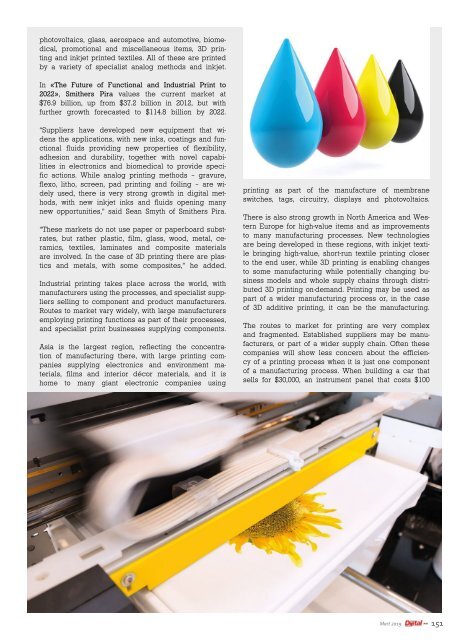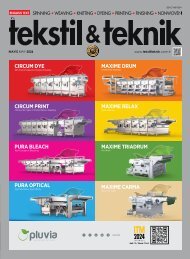Create successful ePaper yourself
Turn your PDF publications into a flip-book with our unique Google optimized e-Paper software.
photovoltaics, glass, aerospace and automotive, biomedical,<br />
promotional and miscellaneous items, 3D printing<br />
and inkjet printed textiles. All of these are printed<br />
by a variety of specialist analog methods and inkjet.<br />
In «The Future of Functional and Industrial Print to<br />
2022», Smithers Pira values the current market at<br />
$76.9 billion, up from $37.2 billion in 2012, but with<br />
further growth forecasted to $114.8 billion by 2022.<br />
“Suppliers have developed new equipment that widens<br />
the applications, with new inks, coatings and functional<br />
fluids providing new properties of flexibility,<br />
adhesion and durability, together with novel capabilities<br />
in electronics and biomedical to provide specific<br />
actions. While analog printing methods – gravure,<br />
flexo, litho, screen, pad printing and foiling – are widely<br />
used, there is very strong growth in digital methods,<br />
with new inkjet inks and fluids opening many<br />
new opportunities,” said Sean Smyth of Smithers Pira.<br />
“These markets do not use paper or paperboard substrates,<br />
but rather plastic, film, glass, wood, metal, ceramics,<br />
textiles, laminates and composite materials<br />
are involved. In the case of 3D printing there are plastics<br />
and metals, with some composites,” he added.<br />
Industrial printing takes place across the world, with<br />
manufacturers using the processes, and specialist suppliers<br />
selling to component and product manufacturers.<br />
Routes to market vary widely, with large manufacturers<br />
employing printing functions as part of their processes,<br />
and specialist print businesses supplying components.<br />
Asia is the largest region, reflecting the concentration<br />
of manufacturing there, with large printing companies<br />
supplying electronics and environment materials,<br />
films and interior décor materials, and it is<br />
home to many giant electronic companies using<br />
printing as part of the manufacture of membrane<br />
switches, tags, circuitry, displays and photovoltaics.<br />
There is also strong growth in North America and Western<br />
Europe for high-value items and as improvements<br />
to many manufacturing processes. New technologies<br />
are being developed in these regions, with inkjet textile<br />
bringing high-value, short-run textile printing closer<br />
to the end user, while 3D printing is enabling changes<br />
to some manufacturing while potentially changing business<br />
models and whole supply chains through distributed<br />
3D printing on-demand. Printing may be used as<br />
part of a wider manufacturing process or, in the case<br />
of 3D additive printing, it can be the manufacturing.<br />
The routes to market for printing are very complex<br />
and fragmented. Established suppliers may be manufacturers,<br />
or part of a wider supply chain. Often these<br />
companies will show less concern about the efficiency<br />
of a printing process when it is just one component<br />
of a manufacturing process. When building a car that<br />
sells for $30,000, an instrument panel that costs $100<br />
<strong>Mart</strong> <strong>2019</strong><br />
151

















